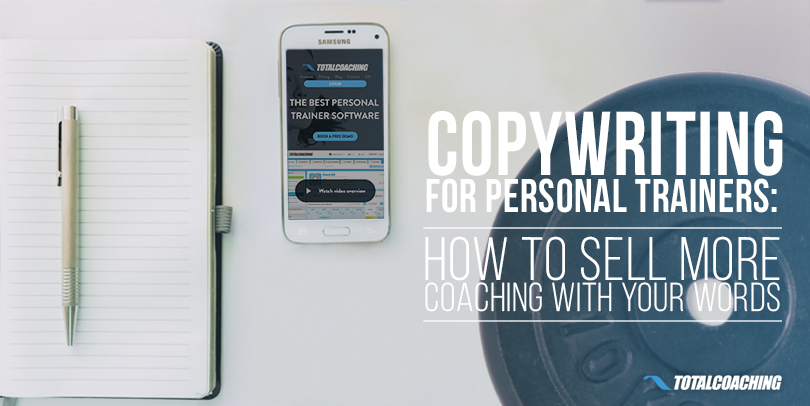Words sell.
Even in today’s modern world of YouTube, Snapchat, Instagram, and Netflix, where we have visuals coming at us from every direction, the written (or spoken) word is still the most powerful tool you have at your disposal when it comes to selling.

Now, ‘selling’ has got kind of a bad rap in fitness. It's sometimes seen as a dirty word. So, let’s clear something up:
Selling does NOT mean tricking someone into buying your product, or hiring you to train them.
You’re good at what you do, right?
You get results?
And you know that if people sign up with you, they’ll drop pounds, get more fit, look better, ultimately live longer, feel happier, and get more confidence.
But getting that across to Joe or Jane Average who thinks fitness is just a chore is difficult … seriously difficult.
With so many quick-fix gimmicks and fad diets out there, the general public’s guard is up, with their B.S. radars on high alert, and to them, you could be just another shady charlatan, out to make a quick buck off their weight-loss woes.
You're not selling Shake Weights, are you? You are offering real value!
So how is a credible, reputable, genuine trainer like you or I supposed to show people just how incredible their life can be if they invest in us?
The answer: Copywriting.
A (Brief) Copywriting Overview
If you’ve ever read a sales page for a product, that’s copywriting.
An infomercial video is copywriting (as the script was written.)
Most emails are copywriting.
Copywriting is anything designed to invoke an action. It’s often known as ‘direct response’ copywriting, as the idea is that it gets a direct response from a reader, whether that response is to click on a link, join a group, perform a task, or the holy grail... sign up and pay for what we have to offer.
Copywriting is NOT lying about how awesome you are, or making false promises. It’s simply putting your value into words.
When to Use Copywriting
You can use copywriting on your...
- Flyers
- Gym posters
- Newspaper and magazine ads
- Website
- Product and service sales pages
- Emails to your client list
- Social media posts
- Anywhere your written word encourages action
copywriting cheatsheet #email vs #socialmedia vs #web #blog #blogger #contentmarketing #emailmarketing #GrowthHacking #webdesign #SEO #ads pic.twitter.com/tyfjuATD1S
— Bharath369 (@Bharath_369) October 1, 2016
The topic of copywriting is absolutely huge, and learning how to be a real A-list copywriter, scoring slam dunks with your words, and crafting sales pages and scripts that make millions of dollars will take years and years of dedicated study.
Here’s some good news though...
Copywriting for fitness is remarkably easy, and with just a few simple tweaks to your words, you can automatically start increasing your sales, building your client base, and boost your revenue.
Tip #1 - Use EMOTION
People don’t sign up with a personal trainer because they want to lose 15 pounds, run a half marathon, or deadlift 300 pounds.
They sign up because they want to feel the confidence that the weight loss gives them, get the adulation from friends for completing the half marathon, and the pride of lifting that 300 pounds.
You aren't selling fitness. You're selling the feeling that comes with being fit.
As an example, you could say:
Lose up to 15 pounds in your first 6 weeks of training.
But a better way of phrasing this would be:
By the end of our first 6 weeks together, I guarantee you’ll have lost weight - even as much as 15 pounds.
Imagine the positive compliments you’ll get from your family, how friends and colleagues will be in awe of your achievements, and just think how much more confident you’ll feel with your body.”
You’ve got to talk to your prospects about the emotional journey they’ll go on with you.
Tip #2 - Pain Over Pleasure
People are more than twice as likely to do something because it removes pain than they are because it gives pleasure.
A potential client reading your sales copy may be feeling stressed out, angry that they’re out of shape, or even embarrassed with their body.
Would You Rather Avoid Pain or Create Pleasure? https://t.co/AfYCicet5B #marketingtips #digitalmarketing pic.twitter.com/obqJr78qO7
— CT Social (@CTSocializer) October 2, 2016
Now there’s a fine line here. You don’t want to lay into them and make them feel terrible about themselves, but you need to highlight some of that pain, tap into their how their pain can be used as a motivator, and then show them how you can make them happier.
Use questions such as:
Are you frustrated that you’ve tried so hard with so many diets, but still have unsightly body fat around your hips and stomach?
Or,
Are you worried that your partner no longer finds you attractive?
It’s then your job to build the reader up, and reveal exactly how amazing they can feel once they contact you.
Tip #3 - Benefits NOT Features
There are many features of your business that you could sell:
- 30-minute exercise sessions
- A delicious nutrition plan
- Brand new equipment including kettlebells and free weights
- Etc.
Features tell someone what’s involved, but they don’t tell them why that’s important or why they should really care.
Someone reading this may just think “So what?” to all of the above. You want them to know exactly why they’re doing something. Tell what benefit they’ll get.
For instance, you could transform the above statement like this:
- 30-minute sessions SO THAT you don’t need to sacrifice your social life or time with your family to achieve the body of your dreams.
- A delicious nutrition plan SO THAT you can eat all your favourite foods, guilt-free.
- We use kettlebells, free weights, and brand new machines SO THAT you never get bored, and so that you burn the maximum calories per minute.
Features tell… benefits sell!
Tip #4 - Give Freebies
This doesn’t mean you need to give free training sessions, but it’s always a good idea to include free, helpful information and advice in your copy.
You don’t want to just write one big, long-ass sales pitch, that gives readers no reason to stick around unless they're absolutely dying to purchase.
You don't have to give away high dollar value freebies, but give away something that is useful to your target client.
Instead, drop titbits of advice into your copy.
For instance, if I was advertising a boot camp, I might throw in a short workout people could try themselves at home.
If it was a diet book, I’d tell people how to figure out their required calorie intake.
Don’t keep all your cards close to your chest. By informing through your copy, not only are you paying your dues to the fitness industry, but you’re also building trust. Even if someone doesn’t invest in you, at least you can sleep soundly knowing that you’ve helped one person get closer to their goals!
The Ethical Dilemma of Copywriting
Plenty of fitness pros have issues with selling. And that’s normal. You don’t want to turn into yet another shady internet marketer, but at the same time, you’ve got to eat.
There’s no reason why copywriting can’t be done ethically, though, especially if you use the four tips we just discussed.
Above all, remember that you know your stuff. You know how to help people lose weight, get fit, live longer, and be better parents/ friends/ husbands/ wives.
You know how to change lives for the better, and THAT is something that warrants selling. Copywriting helps you do that.




